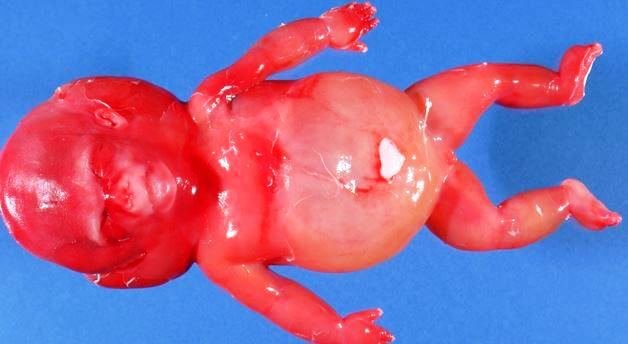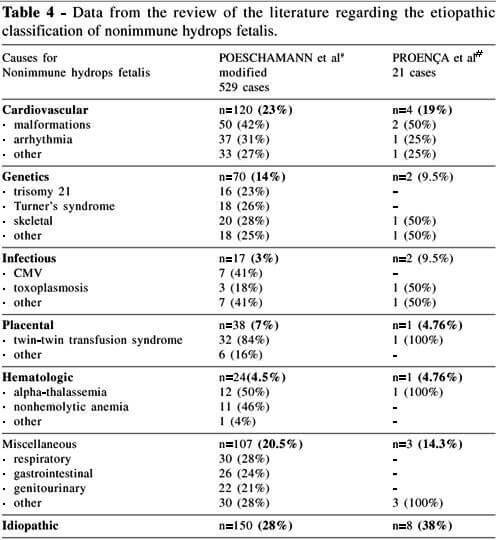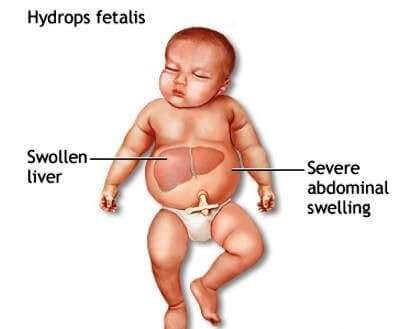Hydrops Fetalis
Definition
Hydrops fetalis which is also known as hydrops, is a life-threatening condition in which an abnormal fluid is accumulated in two or more fetal compartments such as skin edema, pleural effusion, and pericardial effusion. There is also a possibility that the condition may be correlated with placental edema and polyhydramnios.

There are two kinds of hydrops fetalis:
- Immune – This happens when the immune system of the mother leads to a breakdown of red blood cells inside the fetus. It is considered to be the most menacing complication amongst blood group incompatibility for both the baby and mother. This kind of hydrops fetalis is not common due to the extensive use of Rh immunoglobulin in treating Rh negative women.
- Nonimmune – This is the more typical type of hydrops fetalis. It can occur when the baby’s capability to control fluid is interfered with certain complications or diseases.
Causes
Hydrops fetalis forms when an excessive amount of fluid departs from the bloodstream and goes directly into the tissues. A lot of diseases in different kinds and some complications could result to the condition. The type of hydrops fetalis will depend on the cause of the abnormal fluid.

Immune hydrops – They might develop because of Rh disease that is present in the mother. If the mother is an Rh negative, but has an infant who is Rh positive, the mother’s immune system perceives the red blood cells of the Rh positive baby as foreign. When these red blood cells are attacked by the mother’s antibodies, they are damaged and broken down, leading to anemia as well as total body swelling.
Hydrops fetalis can form as the organs of the baby are not able to make up for the anemia. The heart starts to become weaker and large quantity of fluid develops in the baby’s organs and tissues.
Nonimmune hydrops – There is no one process to explain this type of hydrops. There are some complications or conditions that are often associated to be the cause for this type including:
- Turner syndrome
- Severe anemia such as infections or from thalassemia
- Lung or heart problems
- Liver disease
- Developmental or congenital infections
Symptoms of Hydrops Fetalis
Symptoms vary on the severity of hydrops fetalis and may differ on each baby. The most common symptoms of this condition are the following:

- Thickened placenta
- Swelling of the liver
- Large quantity of amniotic fluid
- Fetus ultrasound will show an enlarged heart, liver, or spleen, and buildup of fluid around the lungs, abdomen, and heart
- Pale coloring of the skin
More severe symptoms may include:
- Respiratory distress or breathing problems
- Failure of the heart
- Bruising spots on the skin
- Total swelling of the body
- Severe jaundice
- Severe anemia
Diagnosis
Aside from physical examination and medical history of the patient, the following diagnostic procedures may be done:
- Ultrasound – It is an imaging technique that helps in diagnosing hydrops by showing large amounts of amniotic fluid, abnormally large placenta, and the fluid that results to swelling in the organs and belly area of the unborn baby.
- Fetal blood sampling – It is done my directly collecting fetal blood coming from the fetus. This is helpful for evaluating any signs of anemia and other problems of the blood.
- Amniocentesis (AFT) – A test wherein a small amount of amniotic fluid is taken for diagnostic testing.
Treatment
Treatment for hydrops fetalis is based on its cause. At times of the pregnancy, treatment may involve:
- Intrauterine fetal blood transfusion – Blood is given to the baby in the womb
- Medications – Certain medications to induce an early labor and childbirth
- Early cesarean delivery – Recommended if the condition gets worse
Treatment for a newly born baby may include:
- Direct transfusion – Transfer of red blood cell that equals the blood type of the infant
- Exchange transfusion – Involves the removal of platelets or red blood cells and replacing it with blood products. It can rid certain substances that destroy the red blood cells in the baby’s body.
- Helpful methods to help the baby in breathing such as breathing machine
- Medications that can help the kidneys get rid of excess fluids and manage heart failures
Prognosis
Hydrops fetalis have a poor prognosis since this condition frequently leads to the infant’s death shortly after or before delivery. The risk is even higher for babies who are ill at birth or born very early.
Survival Rate
The rate of survival often depends on the cause and treatment of hydrops fetalis. 80% of cases are accounted for non-immune hydrops and the mortality rate is about 40%. The sequence of hydrops is changing resulting, with an estimation of two thirds are surviving.

References:
- What are the symptoms of hydrops fetalis? at http://www.stanfordchildrens.org/en/topic/default?id=hydrops-fetalis-90-P02374
- https://www.nlm.nih.gov/medlineplus/ency/article/007308.htm
- Abrams ME, Meredith KS, Kinnard P et-al (2007). Hydrops fetalis: a retrospective review of cases reported to a large national database and identification of risk factors associated with death. Pediatrics. 120 (1): 84-9.
- Hydrops Fetalis management, aetiology at http://patient.info/doctor/hydrops-fetalis
- Merz E, Bahlmann F (2005). Ultrasound in obstetrics and gynecology. Thieme Medical Publishers. ISBN: 1588901475.
- Entezami M, Albig M, Knoll U et-al (2003). Ultrasound Diagnosis of Fetal Anomalies. Thieme. ISBN: 1588902129.
